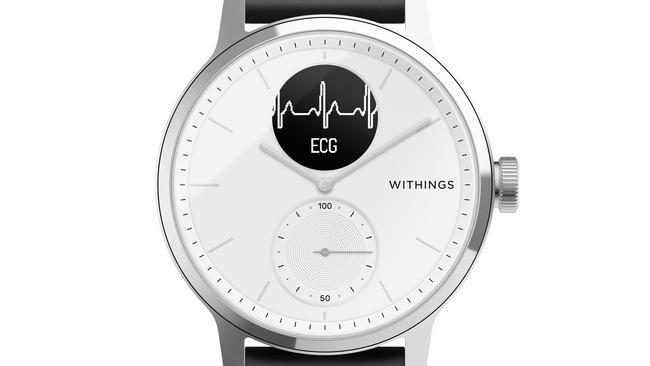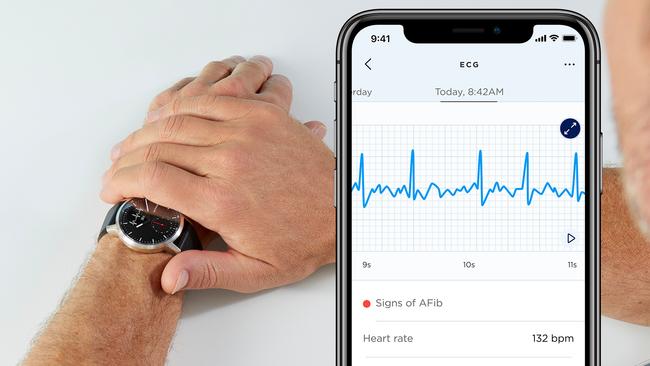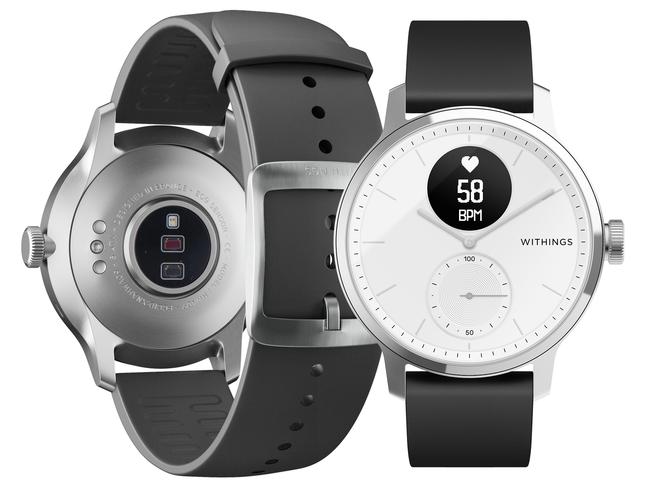Withings ScanWatch review: new smartwatch focuses on health insights
Withings’ new ScanWatch measures heart rate, along with irregular low and high heart rates over time, and purports to detect atrial fibrillation.

Withings has released a stylish smartwatch that could be massively attractive to older Australians. That’s because the Withings ScanWatch measures a swag of metrics such as heart rate around the clock, along with irregular low and high heart rates over time, and purports to detect atrial fibrillation (AFib). It also has a blood oxygen (SpO2) monitor that helps detect breathing irregularities and sleep apnoea, and monitors sleep.
Like some of the French company’s earlier digital watches, it looks like an old-fashioned analog watch with regular hands and a crown. The giveaway that it’s no ordinary watch is the small digital window near the top that is surprisingly useful. You can view basic metrics such as heart rate, steps, distance moved, height gained by rotating the crown.
You can initiate ECG and oxygen saturation measurements by placing your hand over the side of the watch, set an alarm and timer, and select from a variety of workouts for tracking via that window.
The watch tells you when your phone receives a call, and SMSs and emails appears in the small window as a horizontally scrolling ticker. You need to read it attentively because once it’s displayed, it’s gone. You can’t make phone calls from the watch.

Most of your health data is accessed through the Withings’ Health Mate app on your phone, which connects to the watch by Bluetooth. You can also access you data through the web.
Scrolling through the app, I can see my steps, whether my latest ECG reading and oxygen saturation reading is normal, my sleep score from last night, whether there is evidence of breathing disturbances, and an assessment of my fitness level.
You can select these categories to view more granular data, although for me the summary is often enough. It’s a human equivalent of a daily roadworthy certificate for your car and you are not dumped unaided into a fire hose of never ending data.
Withings offers useful indications of trends. Today, it said my ECG was normal and there are no days of signs of AFib. You will be told about changes in sleep time.
Unlike some rivals, Withings has obtained formal medical approval from the Australian Therapeutic Goods Administration.

ScanWatch conducts three measurements. It uses a single channel electrocardiogram to measure heart rate and help detect AFib, a reflectance photoplethysmogram to measure pulse rate and again help detect AFib, and it measures oxygen saturation by the colour of your blood.
Withings says its TGA approval only took a couple of weeks, as it was able to send the same performance information to it as it did to authorities in other countries.
Even though it has this impressive certification, I wouldn’t rely on any one device or depend on its accuracy. Go to your doctor if you perceive a problem, even if the watch doesn’t suggest any. However, ScanWatch can alert you to warning signs. The Withings app lets you create a PDF file of your data that you can hand to your doctor.
ScanWatch claims battery life of up to 30 days. Battery life will be reduced the more you use automatic functionality such as leaving the respiratory scan on permanently rather than having it run a few times per quarter. Continuous monitoring for AFib also will chew into battery life.

The watch’s sleep monitoring displays periods of light and deep sleep, and awareness. Again, the most useful aspect will be trends, where the watch notices you are sleeping less than you did, say, two months ago.
The watch lacks bells and whistles younger users might miss. You can’t make contactless payments with it, control music when you are out, check your calendar for appointments, or read back messages you may have missed. Six months into the pandemic, I’m used to waving a smartwatch over a terminal at a cafe or shop to pay. It’s convenient, and I don’t touch anything, even my phone.
The ScanWatch monitors your exercise but it does not have in-built GPS. Nevertheless, you can see a map of where you went walking or running by giving the watch access to your phone’s GPS. I had to set the GPS to permanently on for the Health Mate app.

The app includes “health insights” such as a pregnancy tracker, meditation sessions and a leader board where you can share your achievements with friends.
Overall, Withings has created a watch that is totally focused on health insights. Existing smartwatch uses might miss some of the extended functionality available on other watches, but those who are not overly au fait with smartwatches may revel in its relative simplicity.
ScanWatch is available in two sizes with a black or a white watch face. JB Hi-Fi will sell the watch from next Monday, November 9, for $479 (38mm) and $499 (42mm).
Withings is also selling a sleep analyser which takes the form of a mat which you place under your mattress. Withings says it will tells you if you have had sleep apnoea episodes. It analyses sleep differently to the watch. It uses a pneumatic sensor to measure respiratory rate, body movement and continuous heart rate and measures sleep durations and interruptions. It also is TGA approved. Cost: $199.







To join the conversation, please log in. Don't have an account? Register
Join the conversation, you are commenting as Logout